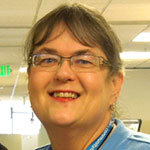Making an Invisible Disease Visible

Many people live with ongoing conditions and have persistent symptoms that keep them aware of the condition. For example, if a person has arthritis, they may have pain and stiff joints much of the time. For those with asthma, they may have shortness of breath during regular activities.
And then there’s diabetes. The thing about diabetes is that a person can live with the disease without knowing it. Why? Because type 2 diabetes is generally asymptomatic in its early stages. Without regular screening, it goes undetected.
The prevalence of undiagnosed diabetes is greatest among non-White culturally diverse groups. It has been estimated that undiagnosed diabetes for non-Hispanic Whites is about six percent, while it is about seven percent for African Americans, 10 percent for Mexican Americans, 12 percent for Puerto Ricans, and as high as 15 percent for Native Americans. Native Americans (American Indians and Alaska Natives) have a greater chance of having diabetes than any other U.S. racial group.
According to the National Diabetes Statistics Report for 2020:
- 2 million Americans have diabetes.
- An additional 88 million American adults (approximately 1 in 3) have prediabetes.
- 2 million adults age 65 years and older have prediabetes.
- People develop type 1 and type 2 diabetes during youth, and type 2 later in life.
- Racial minorities continue to develop type 2 diabetes at higher rates.
- Adjusted data for 2017–2018 indicates that diagnosed cases of diabetes were highest among American Indians/Alaska Natives (14.7 percent).
- 2017 data shows that American Indians/Alaska Natives are 2.5 times more likely than non-Hispanic Whites to die from diabetes.
- Even more alarming, according to the Centers for Disease Control and Prevention and Indian Health Service, diabetes prevalence among adults in some American Indian and Alaska Native communities, is as high as 60 percent.
The signs and symptoms of type 1 and type 2 diabetes include:
- Increased thirst
- Frequent urination
- Extreme hunger
- Unexplained weight loss
- Presence of ketones in the urine (ketones are a byproduct of the breakdown of muscle and fat that happens when there’s not enough available insulin)
- Fatigue
- Irritability
- Blurred vision
- Slow-healing sores
- Frequent infections, such as gums or skin infections and vaginal infections
Left untreated, these symptoms lead to kidney diseases. Fewer than 25 percent of people with moderate to severe chronic kidney disease (stage 3 or 4) are aware of their condition. Diabetes is also the leading cause of kidney failure, a costly condition that requires dialysis or kidney transplant for survival.
Making diabetes visible through community activism
As a graduate of the University of North Dakota (UND) School of Nursing, I receive the UND Alumni Magazine. The summer 2020 edition carried an impressive story about Dr. Monica Mayer (“Her Name is Good Medicine”—reprints available by e-mailing magazine-reprints-alumnimag@UNDalumni.net).
Dr. Mayer was given the name Xubaari Cagi (meaning “good medicine”) by her grandmother, according to tribal custom. She is a tribal elder and council person. And she is a peacetime veteran who served from 1984 to 1990 with the US Army Reserves.
I was so humbled by Dr. Mayer’s story and her passionate advocacy for her community in North Dakota by assessing for poverty, access to healthy food, housing, jobs, transportation, and places to exercise. Health education—particularly about diabetes, addiction, and other public health concerns—is very important to Dr. Mayer.
Now, during the current pandemic, health education is a time of particular concern. As we know, those living with diabetes and other chronic conditions are at higher risk for COVID-19. Dr. Mayer is making sure that elders’ homes receive care packages of Clorox wipes, tissues, toilet paper, hand sanitizer, medications, and grocery gift cards. She also provides thermometers, pulse oximeters, blood pressure cuffs, and instructions and guidance on their use.
How can we follow Dr. Mayer’s lead and make diabetes visible in our communities?
- Encourage people in at-risk communities to get tested for diabetes. African Americans, Native Americans, and Alaskan Natives are at highest risk.
- Encourage physical activity—the less active you are, the greater your risk.
- Encourage healthy eating and weight control. Being overweight is a main risk factor for type 2 diabetes.
- If you live with diabetes, chances are that someone you know also lives with diabetes. Remind them that they’re not alone. Help is available. This is particularly important due to social isolation stemming from COVID quarantine.
- Reach out for support. If you are not directly affected, consider providing encouragement and support to others.
A personal note of thanks
As a diabetic, I know the importance of support. My participation in the Glycemic Reduction Approaches in Diabetes (GRADE) study will end in 2021. I want to thank all the GRADE staff for their support and encouragement over the years. I also want to thank my health care providers at Kaiser Permanente and a community colleague, Kathryn Ramos, who is a Living Well Programs trainer.
 Contributor Mary Pat O’Leary, RN, BSN is a planner with Aging and Disability Services. She leads chronic disease self-management program trainings. For information about diabetes education, e-mail MaryPat.OLeary@seattle.gov.
Contributor Mary Pat O’Leary, RN, BSN is a planner with Aging and Disability Services. She leads chronic disease self-management program trainings. For information about diabetes education, e-mail MaryPat.OLeary@seattle.gov.
![AgeWise King County [logo]](https://www.agewisekingcounty.org/wp-content/themes/agewisekingcounty/images/logo.png)